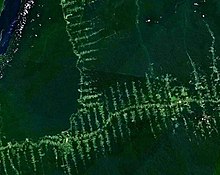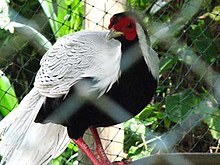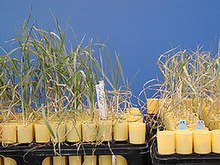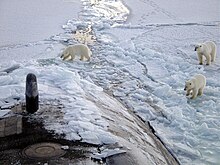Number of species
According to Mora and colleagues, the total number of terrestrial species is estimated to be around 8.7 million while the number of oceanic species is much lower, estimated at 2.2 million. The authors note that these estimates are strongest for eukaryotic organisms and likely represent the lower bound of prokaryote diversity. Other estimates include:
- 220,000 vascular plants, estimated using the species-area relation method
- 0.7-1 million marine species
- 10–30 million insects; (of some 0.9 million we know today)
- 5–10 million bacteria;
- 1.5-3 million fungi, estimates based on data from the tropics, long-term non-tropical sites and molecular studies that have revealed cryptic speciation. Some 0.075 million species of fungi had been documented by 2001)
- 1 million mites
- The number of microbial species is not reliably known, but the Global Ocean Sampling Expedition dramatically increased the estimates of genetic diversity by identifying an enormous number of new genes from near-surface plankton samples at various marine locations, initially over the 2004-2006 period. The findings may eventually cause a significant change in the way science defines species and other taxonomic categories.
Since the rate of extinction has increased, many extant species may become extinct before they are described. Not surprisingly, in the animalia the most studied groups are birds and mammals, whereas fishes and arthropods are the least studied animals groups.
Measuring biodiversity
Species loss rates
During the last century, decreases in biodiversity have been increasingly observed. In 2007, German Federal Environment Minister Sigmar Gabriel cited estimates that up to 30% of all species will be extinct by 2050. Of these, about one eighth of known plant species are threatened with extinction. Estimates reach as high as 140,000 species per year (based on Species-area theory). This figure indicates unsustainable ecological practices, because few species emerge each year. Almost all scientists acknowledge that the rate of species loss is greater now than at any time in human history, with extinctions occurring at rates hundreds of times higher than background extinction rates. As of 2012, some studies suggest that 25% of all mammal species could be extinct in 20 years.
In absolute terms, the planet has lost 52% of its biodiversity since 1970 according to a 2014 study by the World Wildlife Fund. The Living Planet Report 2014 claims that "the number of mammals, birds, reptiles, amphibians and fish across the globe is, on average, about half the size it was 40 years ago". Of that number, 39% accounts for the terrestrial wildlife gone, 39% for the marine wildlife gone and 76% for the freshwater wildlife gone. Biodiversity took the biggest hit in Latin America, plummeting 83 percent. High-income countries showed a 10% increase in biodiversity, which was canceled out by a loss in low-income countries. This is despite the fact that high-income countries use five times the ecological resources of low-income countries, which was explained as a result of process whereby wealthy nations are outsourcing resource depletion to poorer nations, which are suffering the greatest ecosystem losses.
Threats
In 2006 many species were formally classified as rare or endangered or threatened; moreover, scientists have estimated that millions more species are at risk which have not been formally recognized. About 40 percent of the 40,177 species assessed using the IUCN Red List criteria are now listed as threatened with extinction—a total of 16,119.
Jared Diamond describes an "Evil Quartet" of habitat destruction, overkill, introduced species and secondary extinctions. Edward O. Wilson prefers the acronym HIPPO, standing for Habitat destruction, Invasive species, Pollution, human over-Population and Over-harvesting. The most authoritative classification in use today is IUCN's Classification of Direct Threats which has been adopted by major international conservation organizations such as the US Nature Conservancy, the World Wildlife Fund, Conservation International and BirdLife International.
Habitat destruction
Habitat destruction has played a key role in extinctions, especially related to tropical forest destruction. Factors contributing to habitat loss are: overconsumption, overpopulation, land use change, deforestation, pollution (air pollution, water pollution, soil contamination) and global warming or climate change.
Habitat size and numbers of species are systematically related. Physically larger species and those living at lower latitudes or in forests or oceans are more sensitive to reduction in habitat area. Conversion to "trivial" standardized ecosystems (e.g., monoculture following deforestation) effectively destroys habitat for the more diverse species that preceded the conversion. In some countries lack of property rights or lax law/regulatory enforcement necessarily leads to biodiversity loss (degradation costs having to be supported by the community).
A 2007 study conducted by the National Science Foundation found that biodiversity and genetic diversity are codependent—that diversity among species requires diversity within a species and vice versa. "If any one type is removed from the system, the cycle can break down and the community becomes dominated by a single species." At present, the most threatened ecosystems are found in fresh water, according to the Millennium Ecosystem Assessment 2005, which was confirmed by the "Freshwater Animal Diversity Assessment", organised by the biodiversity platform and the French Institut de recherche pour le développement (MNHNP).
Co-extinctions are a form of habitat destruction. Co-extinction occurs when the extinction or decline in one accompanies the other, such as in plants and beetles.
Introduced and invasive species
Barriers such as large rivers, seas, oceans, mountains and deserts encourage diversity by enabling independent evolution on either side of the barrier, via the process of allopatric speciation. The term invasive species is applied to species that breach the natural barriers that would normally keep them constrained. Without barriers, such species occupy new territory, often supplanting native species by occupying their niches, or by using resources that would normally sustain native species.
The number of species invasions has been on the rise at least since the beginning of the 1900s. Species are increasingly being moved by humans (on purpose and accidentally). In some cases the invaders are causing drastic changes and damage to their new habitats (e.g.: zebra mussels and the emerald ash borer in the Great Lakes region and the lion fish along the North American Atlantic coast). Some evidence suggests that invasive species are competitive in their new habitats because they are subject to less pathogen disturbance.Others report confounding evidence that occasionally suggest that species-rich communities harbor many native and exotic species simultaneously while some say that diverse ecosystems are more resilient and resist invasive plants and animals. An important question is, "do invasive species cause extinctions?" Many studies cite effects of invasive species on natives, but not extinctions. Invasive species seem to increase local (i.e.: alpha diversity) diversity, which decreases turnover of diversity (i.e.: beta diversity). Overall gamma diversity may be lowered because species are going extinct because of other causes, but even some of the most insidious invaders (e.g.: Dutch elm disease, emerald ash borer, chestnut blight in North America) have not caused their host species to become extinct. Extirpation, population decline and homogenization of regional biodiversity are much more common. Human activities have frequently been the cause of invasive species circumventing their barriers, by introducing them for food and other purposes. Human activities therefore allow species to migrate to new areas (and thus become invasive) occurred on time scales much shorter than historically have been required for a species to extend its range.
Not all introduced species are invasive, nor all invasive species deliberately introduced. In cases such as the zebra mussel, invasion of US waterways was unintentional. In other cases, such as mongooses in Hawaii, the introduction is deliberate but ineffective (nocturnal rats were not vulnerable to the diurnal mongoose). In other cases, such as oil palms in Indonesia and Malaysia, the introduction produces substantial economic benefits, but the benefits are accompanied by costly unintended consequences.
Finally, an introduced species may unintentionally injure a species that depends on the species it replaces. In Belgium, Prunus spinosa from Eastern Europe leafs much sooner than its West European counterparts, disrupting the feeding habits of the Thecla betulae butterfly (which feeds on the leaves). Introducing new species often leaves endemic and other local species unable to compete with the exotic species and unable to survive. The exotic organisms may be predators, parasites, or may simply outcompete indigenous species for nutrients, water and light.
At present, several countries have already imported so many exotic species, particularly agricultural and ornamental plants, that their own indigenous fauna/flora may be outnumbered. For example, the introduction of kudzu from Southeast Asia to Canada and the United States has threatened biodiversity in certain areas.
Genetic pollution
Endemic species can be threatened with extinction through the process of genetic pollution, i.e. uncontrolled hybridization, introgression and genetic swamping. Genetic pollution leads to homogenization or replacement of local genomes as a result of either a numerical and/or fitness advantage of an introduced species. Hybridization and introgression are side-effects of introduction and invasion. These phenomena can be especially detrimental to rare species that come into contact with more abundant ones. The abundant species can interbreed with the rare species, swamping its gene pool. This problem is not always apparent from morphological (outward appearance) observations alone. Some degree of gene flow is normal adaptation and not all gene and genotype constellations can be preserved. However, hybridization with or without introgression may, nevertheless, threaten a rare species' existence.
Overexploitation
Overexploitation occurs when a resource is consumed at an unsustainable rate. This occurs on land in the form of overhunting, excessive logging, poor soil conservation in agriculture and the illegal wildlife trade.
About 25% of world fisheries are now overfished to the point where their current biomass is less than the level that maximizes their sustainable yield.
The overkill hypothesis, a pattern of large animal extinctions connected with human migration patterns, can be used explain why megafaunal extinctions can occur within a relatively short time period.
Hybridization, genetic pollution/erosion and food security
In agriculture and animal husbandry, the Green Revolution popularized the use of conventional hybridization to increase yield. Often hybridized breeds originated in developed countries and were further hybridized with local varieties in the developing world to create high yield strains resistant to local climate and diseases. Local governments and industry have been pushing hybridization. Formerly huge gene pools of various wild and indigenous breeds have collapsed causing widespread genetic erosion and genetic pollution. This has resulted in loss of genetic diversity and biodiversity as a whole.
Genetically modified organisms contain genetic material that is altered through genetic engineering. Genetically modified crops have become a common source for genetic pollution in not only wild varieties, but also in domesticated varieties derived from classical hybridization.
Genetic erosion and genetic pollution have the potential to destroy unique genotypes, threatening future access to food security. A decrease in genetic diversity weakens the ability of crops and livestock to be hybridized to resist disease and survive changes in climate.
Climate change
Global warming is also considered to be a major potential threat to global biodiversity in the future. For example, coral reefs - which are biodiversity hotspots - will be lost within the century if global warming continues at the current trend.
Climate change has seen many claims about potential to affect biodiversity but evidence supporting the statement is tenuous. Increasing atmospheric carbon dioxide certainly affects plant morphology and is acidifying oceans, and temperature affects species ranges, phenology, and weather, but the major impacts that have been predicted are still just potential impacts. We have not documented major extinctions yet, even as climate change drastically alters the biology of many species.
In 2004, an international collaborative study on four continents estimated that 10 percent of species would become extinct by 2050 because of global warming. "We need to limit climate change or we wind up with a lot of species in trouble, possibly extinct," said Dr. Lee Hannah, a co-author of the paper and chief climate change biologist at the Center for Applied Biodiversity Science at Conservation International.
A recent study predicts that up to 35% of the world terrestrial carnivores and ungulates will be at higher risk of extinction by 2050 because of the joint effects of predicted climate and land-use change under business-as-usual human development scenarios.
Human overpopulation
From 1950 to 2011, world population increased from 2.5 billion to 7 billion and is forecast to reach a plateau of more than 9 billion during the 21st century. Some recent forecasts place the possible number of people on the planet at 11 billion or 15 billion by 2100. Sir David King, former chief scientific adviser to the UK government, told a parliamentary inquiry: "It is self-evident that the massive growth in the human population through the 20th century has had more impact on biodiversity than any other single factor." At least until the middle of the 21st century, worldwide losses of pristine biodiverse land will probably depend much on the worldwide human birth rate.Biologists such as Paul R. Ehrlich and Stuart Pimm have noted that human population growth is one of the main drivers of species extinction.
According to a 2014 study by the World Wildlife Fund, the global human population already exceeds planet's biocapacity - it would take the equivalent of 1.5 Earths of biocapacity to meet our current demands The report further points that if everyone on the planet had the Footprint of the average resident of Qatar, we would need 4.8 Earths and if we lived the lifestyle of a typical resident of the USA, we would need 3.9 Earths.
The Holocene extinction
Rates of decline in biodiversity in this sixth mass extinction match or exceed rates of loss in the five previous mass extinction events in the fossil record.Loss of biodiversity results in the loss of natural capital that supplies ecosystem goods and services. From the perspective of the method known as Natural Economy the economic value of 17 ecosystem services for Earth's biosphere (calculated in 1997) has an estimated value of US$33 trillion (3.3x1013) per year.





No comments:
Post a Comment